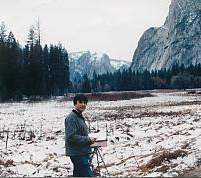

Let's talk about painting ... outdoors. A few years ago a big trend of outdoor painting started in the U.S. Artist and art magazines call it by a french term "plein air". It is also lesser know as painting "sur le motif" . In plain old New World English it's: "painting outside" with your model or (motive-ation or the reason for the art) before you.
A whole slew of painters has jumped on board with this style of painting. I personally have nothing against painting outdoors and I do quite a lot of it. I do have issues with the rhetoric that makes artist's sound as if they really have some sort of edge because of it. I occasionally peruse through artist magazines and I'm amazed at just how repetitive artist can be at boasting. They boast in trends. The flavor of the decade is implying that painting outdoors makes the art "better". For the uniformed, let me inform you, it is a marketing trend for a certain group of landscape painters. I'm sorry to say that just because it was painted outdoors doesn't make an artist automatically produce "good" art. The reverse is similarly true; landscapes painted indoors aren't automatically bad.
Painting outside is an exercise for a painter. First of all, speed is darned important because the sun in constantly moving and changing how things look. The first time an outdoor painter gets 2 plus hours into a painting they will surely know what I mean. Second, a painter will start to see how nature really is, how light bounces off objects, how adjacent colors affect each other. They will learn this if they have developed their eye. If they don't have a trained eye/mind then they will miss the lessons of painting outdoors. They would miss the lessons inside with a setup as well. Then again that's one major reason to go paint.
Briefly "A trained eye." means an artist has learned to see things as they really appear and not how they think they appear. This really means that they have trained their brain to ignore their thoughts and actually pay attention to their sight.
Now when it comes to outdoor painting, the really good painters understand that the "art" is what the painter brings to the party. You can learn to paint what you see and that is good. When a painter gets better, they learn to bring themselves to the scene. Great outdoor painters will usually paint something that isn't at all what is before them. They make it better by their minds. They enhance and modify , they subtract, dissect and reassemble the paintings. Thomas Cole prescribed that an artist should go to the landscape, see the sights, make a sketch and go home. He talked of letting the details fall away into forgetfulness and then making the painting. I should note, it is believed Thomas Cole did do outdoor sketches as well.
A skilled painter can sit inside on a dark night and paint landscapes much, much better than a slew of "plein air" painters that have not reached maturity as artists. All the hoopla is most often about nothing or nothing more than a marketing ploy to fool unaware collectors. If you don't think a landscape painting has much going for it, it probably doesn't.
One last note: Sometimes an artist does a "study" outdoors and tries to match everything right on. These studies are sometimes sold as they are. Studies are not done to be "paintings". In other words, the effort may have been to reproduce exactly what they saw and not to make something that would be understood as a "finished painting". In a "finished painting" an artist is trying to create a certain balance, color and contrast as they think would be best.
About the paintings: The blue painting was done inside my studio from out of my head. The gray painting was done as an outdoor painting done inside ie. I sat in my house and looked out the window. The gray painting pretty exactly captures the mood of the overcast day that it was painted on much as a "study" would. The blue piece was from my head and captures the blue idea that was inside my brain. It has what I felt would make a nice cold bluish idea with some warm yellowy sunlight streaking in.

No comments:
Post a Comment